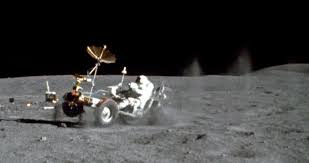No, the entire wheel is sufficiently flexible that all of it interacts with the regolith. The wheels threw up huge amounts of dust because the dust could get in through the mesh and then be thrown out again. You don't get to dismiss the main construction of the wheel so you can focus on the smooth metal parts just because they fit your argument better.
How ironic that someone who describes the tyre setup as
"flexible and a wire mesh", thereby completely ignoring the chevrons, should accuse me of focusing on the area that suits my argument

We'll look at the witness marks should we? It looks to me as though the wire mesh does not touch the ground at all except for maybe between the chevrons, of the two of us I certainly represented the tyres in a way that is supported by the evidence.

Here's a photo of The Apollo 17 LRV being fitted to Jack Schmitt and Eugene Cernan before it is stowed on the LM seen in the background. Notice that there are supports under the frame so it will hold their weight in Earth gravity.

Yes those supports are needed under the frame because it is such a delicate little flower that it can't even
"hold their weight", yet on the moon those
same masses can literally jump onto the rovers and then slam them into bumps all they want without any concerns.

[/quote]
Were they delicate, or sturdy? Apparently both.
So delicate they can't be sat on, yet sturdy enough that they can be driven on bumpy uneven surfaces with confidence. The "with confidence" part is very important, on the moon any accident could result in death so they had to be confident that these vehicles, that could not even be sat on, would not fail over bumpy terrain.
Normally the opposite is true, you might be able to sit on and even ride a kids bike on a smooth surface for example, yet not ride it over a bumpy surface.
Whatever ye do don't question this paradigm shift lest ye be called a conspiracy nutter.